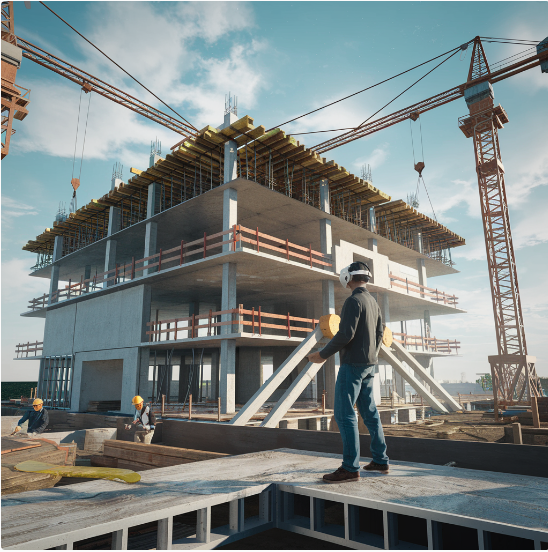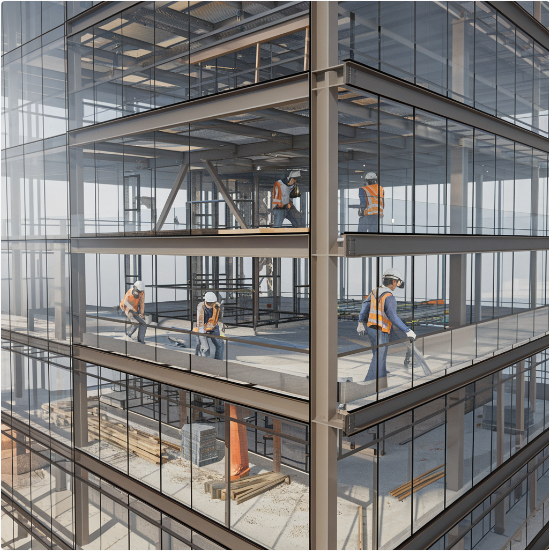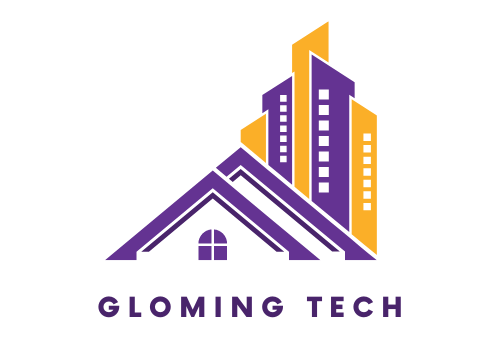Introduction: Virtual Reality Building Construction

Virtual reality is changing the construction industry completely by changing the process of building structures as well as their conception, design, and even use. A further advantage of VR is today’s enhanced feasibility of putting architects, engineers, and clients into the same virtual 3D space and working on the project in a more cohesive manner long before the first stone is placed. This state of the art technology further assists in anticipating design problems, advances safety training procedures and improves overall effectiveness of the project. Ranging from strategies to getting the job done on site, building construction is being improved through the use of virtual reality. The more we dive into the practical application of VR for construction, the more perspectives it offers for completing tasks in an extraordinary way.
The Rise of Virtual Reality in Construction
Virtual reality is rapidly becoming one of the most important tools in construction teams. What was once thought of as a concept only for the future is now being heavily utilized to mitigate misgivings in communication and collaboration among construction teams. Virtual reality now allows construction companies to create virtual worlds that both their clients and employees can visualize through a screen before construction itself is even started. This shift is not only enhancing productivity but is also minimizing costs and mistakes.
Understanding VR’s Role in Design
With VR, architects and engineers can test out their designs in a simulated three-dimensional environment. This capability changes the construction design process from using static overlapped figures to dynamic three-dimensional models. If a head-mounted display is used, then the client is placed in a virtual construction environment and can see a building and explore its space, design, and usability. Such involvement makes it easier to understand the intent behind design decisions and allows clients to make better informed choices.
Enhancing Project Management with VR
Construction projects are always accompanied with barriers and complexities in their management. Such barriers are lowered by VR due to its ability to provide data visualization in a frictionless manner. It helps to master progress and preempt unexpected complexities. Managers deploy VR and walk the sites virtually so that all the project parts are clear for all the participants of the project.
Training and Safety in a VR World

Safety training cannot be neglected in the field of construction. VR provides such an environment where the workers can repetitively practice procedures in safety. They are trained to work in a risk environment by using VR. Research has shown that when individuals are trained using VR, the retention is higher compared to being taught in the traditional way. Hence it can be concluded that VR is effective for education and safety.
Virtual Reality and Cost Efficiency
Construction companies can view the flaws in designs before actually constructing it using the construction documents if they wish to visualize it in VR. Such a strategy will help in preventing rework due to design changes during the construction stage which is expensive. With VR, better resource planning is possible with accurate estimates of material requirements through detailed simulations. As a result, this leads to less waste generation and better cost control.
Improving Client Communication
Based on drawings, clients quite often find it difficult to understand the concept of the intended projects. VR provides a solution to this problem by making it possible to get a more detailed and realistic preview of what the project should be like. Clients are provided with the opportunity to make alterations to virtual models that they feel suit their preference. This way, clients are satisfied with the project and receive exactly what they ordered.
Case Study: VR Success in Real Projects

One of the best examples is Skanska, an international construction company, which makes use of VR in almost all its processes, for example, in the design process, where virtual and augmented reality helped the company cut down its design time by 50%. They developed 3D representations of hospital spaces in the pre construction stage to solicit the opinion of healthcare employees. Such an approach allowed hospital staff to test the newly opened facility and considerably increased the chances of project success after the construction.
Overcoming Challenges with VR Adoption
However, in general, evaluating these advantages there are barriers to the use of VR in construction that can hardly be neglected. First, the cost of VR equipment and training processes is quite high and unaffordable for a number of companies. And second, the introduction of VR into the current infrastructure is a complicated and costly matter. However, as these processes evolve further and the general technological environment expands, these constraints are vanishing step by step.
The Future of Virtual Reality in Construction

Thus, the outlook of the use of VR in the construction industry is positive. The VR sector is quite large and with the current trends in the transition toward various ecosystems, augmented and interactive technologies are slowly moving up the ranks as the hardware and software supporting this sector develop. Moreover, with the advancement of the AI field, the integration of AI with VR is likely to provide even richer data for even more intelligent business decisions which will be beneficial to construction. As VR gets implemented by the market, the winners in this race will most likely be the early adopters of VR technology.
How to Get Started with VR in Construction
Most companies aiming to implement VR into their operations should seek to pilot such technologies. This can be done by prioritizing areas with the highest potential for employing virtual reality e.g. design reviews or safety training. First, basic VR equipment should be acquired and implementation of pilot projects should commence to demonstrate the value. Work with VR professionals to develop the most suitable solutions for your goals.
Leveraging VR for Competitive Advantage

VR applications have the potential to improve construction processes while also giving a company a competitive advantage. Companies that manage to implement VR will be able to offer differentiated services. This competitive advantage may help in acquiring new clients and retaining the current ones which will help the company grow stronger in a competitive environment.
FAQs: Virtual Reality Building Construction
How does Virtual Reality (VR) integrate with building construction processes?
Answer: Construction industry finds VR application in making the 3D images of structures before actually putting them up. This is to say that designers and other relevant parties can see what the building will look like, adjust the plans to solve the foreseeable problems, and do so in real time. It also helps construction workers train in an unrealistic but risk-free context which makes it safer for them to practice their work.
What are the advantages of the application of VR in construction projects?
Answer: Use of VR in construction increases teamwork, manages the design process efficiently, minimizes generation of errors that warrant rework, as well as enhances the ability to evaluate safety parameters. It also speeds up operations since–a large number of people engage in the process and multiple perspectives on a single idea or structure are provided.
Is it in any way possible that the construction process can be made efficacious by making use of VR to improve safety?
Answer: Yes, the training which is provided using VR is realistic as it is done in a controlled environment, meaning real danger does not exist throughout the training process. This can very well enable construction teams to deal with actual threats in the real world which leads to making construction sites less dangerous and consequently reducing the number of injuries.
Has any VR technology been created for use in building construction processes, and if so what is it?
Answer: The basic tools include mostly VR goggles (namely Oculus, HTC Vive), Computers or other gadgets that can be used to deploy special software for VR, in addition, these include special programs for visualizing constructions: Autodesk Revit or Unity that can utilize VR.
And how does the adoption of VR technology affect project construction costs?

Answer: The VR technology investment can be regarded as an initial cost which may seem high but it will reduce the overall project costs due to the decreased number of mistakes, fewer design revisions, and lower amount of rework increasing the efficiency of construction activities.
Conclusion: Virtual Reality Building Construction
Virtual reality (VR) is revolutionizing the construction industry through better design presentation, enhanced interaction, and better safety. Because of VR, through immersive 3D simulations, the project can be realized at every stage by the participants before its physical construction, making it easier to make decisions and fewer mistakes that are expensive. Plus, it’s great for decreasing the hazards associated with work environments. Although the cost of outlay for VR technology is high, the available benefits in future time such as fewer mistakes, less time to complete a project, and better cooperation of team make it a useful technology. With VR technology, there will always be a process of development which will possibly result in rapid changes to improve building processes.
